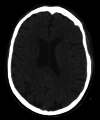Severe Heat Stroke Resuscitation Using a Body Bag in a Community Emergency Department
- PMID: 37746445
- PMCID: PMC10517704
- DOI: 10.7759/cureus.44045
Severe Heat Stroke Resuscitation Using a Body Bag in a Community Emergency Department
Abstract
Heat stroke can lead to severe complications such as end-organ damage and death. The primary treatment modality for heat stroke is rapid cold-water immersion to lower the patient's body temperature. This typically requires a large bath to place the patient in, which may not be available in small or community emergency departments. Although rarely present in the literature, a body bag for cold-water immersion can be used if a bath is not available. Here, we present a case of a 63-year-old male who presented to the emergency department unresponsive with hyperthermia after a heat wave warning was issued. After a thorough workup and imaging, the patient was given IV saline and naloxone, which did not improve his condition. Therefore, the patient was placed in a body bag filled with cold water and ice until his body temperature reduced to 100°F, after which he was removed and closely monitored. The patient was safely discharged and only required repeat lab work three days after discharge. This case highlights a unique technique that emergency physicians can utilize in scenarios where a typical cold-water immersion setup and execution are not possible.
Keywords: body bag; emergency medicine; heat stroke; hyperthermia; resuscitation.
Copyright © 2023, Pittala et al.
Conflict of interest statement
The authors have declared that no competing interests exist.
Figures
References
-
- Heat stroke. Leon LR, Bouchama A. Compr Physiol. 2015;5:611–647. - PubMed
-
- Ice water immersion - practicalities for monitoring hyperthermic patients in the prehospital context. Holbery-Morgan L, Carew J, Bourke E, Douglas N. Prehosp Disaster Med. 2019;34:675–676. - PubMed
-
- First aid cooling techniques for heat stroke and exertional hyperthermia: a systematic review and meta-analysis. Douma MJ, Aves T, Allan KS, et al. https://doi.org/10.1016/j.resuscitation.2020.01.007. Resuscitation. 2020;148:173–190. - PubMed
-
- A novel technique for ice water Immersion in severe drug-induced hyperthermia in the emergency department. Wang AZ, Lupov IP, Sloan BK. J Emerg Med. 2019;57:713–715. - PubMed
Publication types
LinkOut - more resources
Full Text Sources
Miscellaneous



